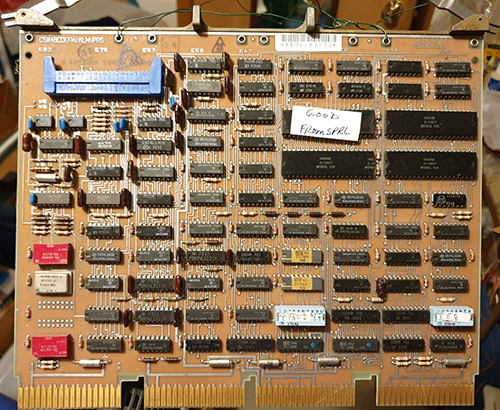The Ware for December 2019 is shown below.
This one should be cakewalk, especially because I left some significant hints visible.
I love the construction of the ceramic decoupling capacitors — they look like modern surface-mount capacitors that have been put into retro glass tubes to give them through-hole legs!

Leaving the DEC logo in the upper right gave it away :)
It’s a DEC DZV11-A module, number M7957: http://bitsavers.trailing-edge.com/pdf/dec/qbus/EK-DZV11-UG-002_DZV11_Asynchronous_Multiplexer_Users_Guide_Aug78.pdf
Looks like some kind of 4-channel RS232 interface.
Yup, my first thought was unibus, but it’s not big enough, qbus it is, a dzv11
My guess was a PDP-8 or 11 in one of its incarnations, but others meat me to it.
DEC/PDP because of the gold lidded chips with DEC on them.
Definitely some sort of 232 serial interface. But I’ll go out on a limb and say floppy drive controller for the fun of it.
I see a ribbon cable connector, and guess it is a rk02 hard disk controller.
Maybe even a disk pack!
Was at DEC from 87 to 97, I think every component had a DEC internal part number in the format 2-5-2 (number of digits). I think 21 was the prefix for MOS and 19 for bipolar. If chips were custom for DEC, they had the DEC pn. I wonder what those Intersil parts are, I’d guess UARTs.
[…] Read More… […]
This board is definitely a DEC DZV11 async multiplexer. It was manufactured at DEC’s Albuquerque plant (the AB code on the QC stamps and initial 2 characters of the serial number label show this).
The decoupling capacitors are glass cased ceramic devices and as I recall were mostly supplied by Unitrode. They had the advantage of being smaller than any alternatives – being able to fit holes on a 0.25 inch pitch – and were also insertable with an automated axial lead inserter.
The glass-encapsulated caps are also great for all sorts of dead-bug homebrewing, e.g. http://www.ke5fx.com/ac/testbed.jpg . They have the advantage of being more or less indestructible (and hence more or less infinitely reusable) compared to the crappy epoxy-encapsulated parts.
You will notice that they use the DEC alphabet.
It omits I and O to avoid confusion with one and zero.
It also omitted G and Q.